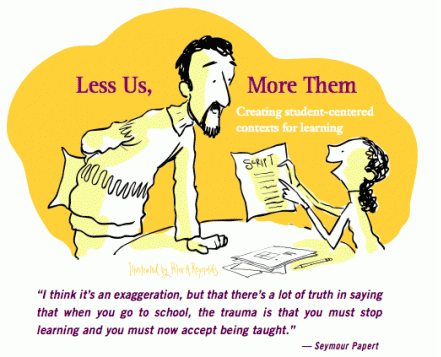
Computer science education has shifted its focus to improving human-computer interaction(HCI) to improve student learning. The invention of new technologies like “Blocky” programming, allows us to move beyond teaching computer interfaces– to improving comprehension and knowledge. Through the adding of tools that adapt to learners abilities and choices, technology designs are making it easier to use learner centered instructional strategies by supporting the integration of scaffolding, modeling and additional tools.
These additional tools should be a student’s choice, available when they need or want the assistance. Software that enables learners to learn by doing, by constructing artifacts and collaborating with others motivates students. The professional development focus for teachers should be on what students are to learn and how to address the different problems students may have in learning that material. By directly focusing on what students are expected to learn and the instructional strategies best suited to teach that content, teacher learning activities lead real changes in teaching and will contribute to improved student learning.
Teacher motivation to engage in professional development begins when learning is job embedded. The optimal workplace is where learning is considered to be part of work. Learning opportunities should be organized around collaborative problem solving. Collaboration to address issues and concerns provide teachers the opportunity for professional teaming to address common concerns and possible solution. To embed real change, it should be continuous and ongoing, and involve follow-up and support. Implementing learner-centered professional development is different work. Research has shown (Hawley) that these design principles will increase student learning. The etools4education included the chart below to illustrate the differences and explain what the transition would look like.
| Traditional Professional Development | Learner-Centered Professional Development |
| Reliance on workshop-type offerings with little feedback for teacher participants | Continuous professional development that uses feedback and reflection to deepen teachers’ knowledge and skills |
| Central office control over professional development activities | Principals and teachers plan and implement most professional improvements |
| Disconnected from the day-to-day experiences of teachers | Learning through professional development embedded in the daily work of teachers |
| Little, if any, correlation between professional development and school improvement plans | Professional development considered central to continuous school improvement |
The transition from traditional methods to learner-centered will require work. Many districts are moving in this work, establishing processes and procedures, creating collaborative ownership and direction. It’s through the dedication to improving the quality of teaching that we will see the largest impact on students’ learning.
“Most importantly learner-centered professional development will change how we think about educators and teaching.”(etools4learning)
References:
Bishop, D, Lumpe, A., Henrikson, R, & Crane, C. (2016). Transforming Professional Learning in Washington State – Project Evaluation Report. Seattle Pacific University: Seattle, WA. http://www.k12.wa.us/CurriculumInstruct/WA-TPL/pubdocs/2016-WA-TPL-Evaluation-Report.pdf
Etools4Education. (n.d.). Retrieved February 12, 2017, from http://www.online-distance-learning-education.com/learner-centered.html
Hawley, W. D., & Valli, L. (2000). Learner-centered professional development. Research Bulletin, 27(1), 7-10.
Soloway, E., Guzdial, M., & Hay, K. E. (1994). Learner-centered design: the challenge for HCI in the 21st century. Interactions, 1(2).
U.S. Department of Education, Office of Educational Technology. (2016). Future Ready Learning Reimagining the Role of Technology in Education 2016 https://tech.ed.gov/files/2015/12/NETP16.pdf
Thanks Shannon- I flagged this for follow-up so I can use that image (totally struck me) and that table from etools4education. I’d like to look a little further into the workshops vs. continuous development based on feedback. To me, that sounds like smaller PLCs that meet regularly. Thanks for for sharing!